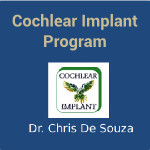Otosclerosis (Otospongiosis), Stapedectomy and Hearing Loss
View Video
Otosclerosis is also known by the term otospongiosis. It is fundamentally a disorder of bone remodelling. It involves only the otic capsule. It undergoes two phases:- (a) The dormant (sclerotic) phase
- (b) The active (spongiotic) phase.
The causes of this order are considered to be due to
- (a) Fluoride deficiency
- (b) hereditary
- (c) Caused by the measles virus.
It affects more women than men and is noticed that it gets activated at pregnancy. Persons in their twenties first show symptoms. It usually affects both ears simultaneously.
It first presents with a hearing loss which increases over time.
The tests that indicate that otosclerosis (otospongiosis) is the likely cause are found on audiometry. The tests are:-
- Pure tone audiometry which show conductive hearing loss with a dip at 2Khz which is known as Carhardts notch.
- peech audiometry show an elevated speech reception threshold with an excellent discrimination score.
Impedance (immittance) audiometry shows
- (a) Low compliance,
- (b) normal middle ear pressures,
- (c) Absent stapedial reflexes.
Are CT scanning or MRI helpful in the diagnosis of otosclerosis (otospongiosis)?
CT scanning is effective only in the active (spongiotic) phase and a lucent area can be seen in the area where the focus is active. However CT scanning has other advantages in that it will very clearly demonstrate the anatomy of the ear. If surgery is considered the operating surgeon will be aware in advance of possible problems that could present difficulties during surgery.
MRI of the temporal bone is not quite as useful as C T scanning.
What are the treatment modalities for otosclerosis?
(A) Medical management:Sodium fluoride. This is now not commonly used. It is thought to arrest the disease in its active phase (spongiotic)but cannot prevent its occurrence.(B) Hearing Aids: These can be used to improve hearing by amplification. Usually since both ears ae involved hearing aids need to be worn in both ears. Advantages: There is no risk of going deaf. Disadvantages are that they are expensive, not covered by insurance and need to have frequent maintenance and battery changes and upgrades.
(C) Surgery: Stapedectomy or stapedotomy. Advantages: Successful surgery restores hearing without the need for amplification.
Disadvantages:- Individuals undergoing surgery run the risk of severe profound irreversible sensorineural deafness following stapedectomy (stapedotomy) surgery. Each patient should decide for themselves the course of action they would like to take after satisfying themselves withthe surgeons experience, competence and success.
Cochlear Implant for Hearing Loss in Adults
Cochlear Implant for Hearing Loss in Children
Surgical steps for stapedectomy (stapedotomy) are as follows
Warning - Contains images of the operation !
- Elevation of the tympanomeatal flap
- Enter the middle ear and expose the incudostapedial joint.
- Curette the over hang so as to improve exposure of the incudostapedial joint and stapedial muscle and oval window.
- Dividing the stapedius muscle tendon.
- Separating the stapes from the incus.
- Fracturing the stapes superstructure towards the promontory.
- Harvesting perichondrium or vein graft to seal the new opening (neofenestra) that is created in the oval window.
- Placing the perichondrial / vein graft over the neofenestra.
- Placing the prosthesis into the neofenestra.
- Clipping the prosthesis on to the long process of the incus.
- Crimping the prosthesis over the log process of the incus so that it does not move
- Replacing the tympanomeatal flap.

